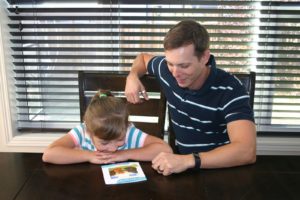I must confess: I am a FIXER.
Part of the problem with being a fixer is that makes you critical. You see problems where maybe there are no problems. You look for problems. You CREATE problems (just ask my wife!)
When I encounter a problem, I feel compelled to address it. It worms its way into my brain and sits there nagging at me.
This can be aggravating as it creates a perfectionist in me – I want to find the perfect solution. I am constantly tweaking things and never satisfied. Because of that, I always feel a need to completely and thoroughly understand the problem.
I am now entering my 10th year of professional practise, and I have worked at least some of every year in the public school system in some capacity. I would frequently receive referrals to complete assessments with children in Grade 4 and beyond who weren’t learning to read at the expected rate.
On some level, the purpose of the assessment was always the same – WHY aren’t they reading?
This really BUGGED me.
However, it was often difficult to isolate just which part of language was not being processed – vocabulary and semantic association? Sound-level processing? Word-level processing? Syntax and Sentence-level processing? Discourse-level processing? Morphology and grammar? Social Communication and the Social Context?
There are a number of tests at our disposal, and it can be tricky to isolate the problem. It can require a lot of testing. And a lot of report writing!!
So, What Has Changed?
What I know now that I didn’t know then is how to recognize red flags and characteristics in a student’s profile. I can make a fairly consistent and accurate hypothesis of a child’s language processing profile from interacting with them for a short time. Then I can select the right test to confirm my hypothesis.
Over time, I learned how to effectively assess students to pull out the areas of challenge. Many times, though, I would arrive at scores that described the child’s language profile. But I still didn’t know WHY they weren’t reading!
The WHY …
I have worked in over 44 public schools, and I have seen that literacy, and reading, has historically been the domain of Psychologists, Literacy Coaches, Learning Coaches, Resource Teachers, Student Support Teachers, Literacy Specialists, or Special Education Teachers.
Most often, my assessment would reveal an impairment in some aspect of the language profile – a difficulty in processing some element of language. However, even with our team approach, we weren’t any closer to really understanding WHY a child wasn’t reading – instead, we had a “grocery list” of scores to describe their attention skills, working memory, processing speed, auditory comprehension, and expressive language.
What was missing was someone to put together those scores, those component sub-skills, into a holistic learner profile.
This requires an understanding of how typical children learn to read, and what goes wrong in the brain when they don’t.
I NOW KNOW “WHY”
I have gotten a lot better at interpreting test scores and results. Over the course of 10 years of university and 10 years of practise, I finally understand the big picture of language and literacy and can predict how difficulties on a certain sub-test will impact actual, functional learning tasks.
Listen, reading is COMPLICATED. Everyone tries to simplify it but reading requires massive processing and connection across the whole brain – from the top to the bottom and the back to the front, there is a role for every piece of anatomy in there. There is a lot that can go wrong.
I can now very quickly and efficiently tell you why a child isn’t reading. Do you think that helped my brain at all, to understand WHY?
NOPE. Because I’ve found a new problem: No one seems to know what to do about it.
FINDING THE “FIX”
I have seen all kinds of practises and programs across the more than  40 some schools I have worked in. After finally understanding all the reading research, the neuroimaging, the impairment models and underlying theories, it was easy to start poking holes in the way reading is taught out there.
40 some schools I have worked in. After finally understanding all the reading research, the neuroimaging, the impairment models and underlying theories, it was easy to start poking holes in the way reading is taught out there.
What really BUGGED me is that after all of our assessment and pages upon pages of reports, I rarely saw anything CHANGE in the way reading was taught.
Most often, I would see boxed intervention “kits” and children being pulled out into the hallway or going for their small-group reading lesson. This is what they did BEFORE assessment, and this is what they did AFTER. Nothing changed.
One of the most important questions, or series of questions, that I think you can ask is this:
- Is your child reading at grade level? If not, WHY?
- Was your child a year or more below grade level for all of last year? Are they STILL? WHY? And WHOM is going to do WHAT about it?
This is a serious puzzle, and definitely a problem, and it really started to drive me an compel me. Beyond my research into assessment and understanding reading, I clearly understood that what was missing was effective instructional methods and materials to teach those children who learn differently. I went a little bit squirrely – I was really frustrated by seeing children receive the same instruction year in, year out.
Ready for the Soap Box?
There are many “programs”, “methods”, and products. Let me clearly state that no product or program will work for all children – they need individualized instruction that matches how their brain works. To choose one program for all children is like throwing everything at the wall to see what sticks.
If your child is receiving a “program”, or a “kit”, or is seen by someone trained in the __ “method”, consider that if it works, it’s luck – that program happens to have some elements that match your child’s learning profile – and you have just won the lottery.
Many activities are cute, engaging, fun, appealing, or “seem to make sense”. Problem is, they don’t WORK.
In the time I have spent learning what to do (and what NOT to do), there are only a few things that work:
- Activities must be functional
- Activities must be integrated
- Activities must be research-based and reflect what we know about childhood reading from brain imaging research.
- There must be an explicit and systematic instructional component
- There must be an error processing system built-in so children can develop meta-cognitive skills
Reading and writing are just the sounds, words, and sentences of “speech” that have been captured on a page or a screen.
I argue that there is NO ONE more qualified than a cognitive neuroscientist to understand the reading. And, I then argue, there is NO ONE more qualified than a Speech-Language Pathologist to deliver instruction, intervention, remediation, or therapy in reading.
No one has been trained to provide individual and small-group instruction in sound, word, and language processing to the depth, breadth, and mastery of Speech-Language Pathologists.
And that is precisely what is required when a child does not read, write, or spell at the expected developmental pace.
A Master Stands in the Question Rather than Looking for the Answer
Lewis Carroll wrote, “do we decide questions, at all? We decide answers, no doubt: but surely the questions decide us?”
We as humans are driven by curiosity. It is the question that has called me and compelled me into a life, a career, and a passion for reading. Why isn’t a given child reading? What do we need to put in front of them to have their brain make sense of the sound-letter code?
I am CONVINCED that all children can learn to read with the right instruction before them. The question of WHY they do not continue to drive me.
Because it is not about arriving at a therapy that is “good enough” or “works for most kids”. It is not about the destination, the ANSWER; it is about the question; the inquiry; the discovery. That is what calls and shapes me and it is what has driven and shaped this business (it definitely isn’t driven by profit margins!)
See, I’m a FIXER. And while I have a long way to go before I have finished perfecting my therapy, my instruction, my materials, the sequence of my curriculum, the strategies and visuals, I DO BELIEVE that the unique and individualized therapy that I have put together takes the best of everything out there, trims the fat, and integrates current research from brain imaging studies into functional, real-world literacy tasks.
I never assume I have arrived; I never stop questioning that there is a way to further improve, and I never stop asking WHY.
It gets in my brain and drives me nuts – someone needs to fix this FIXER!

